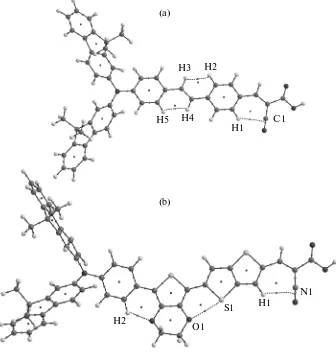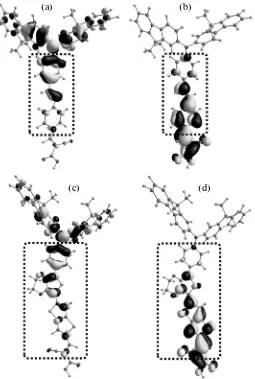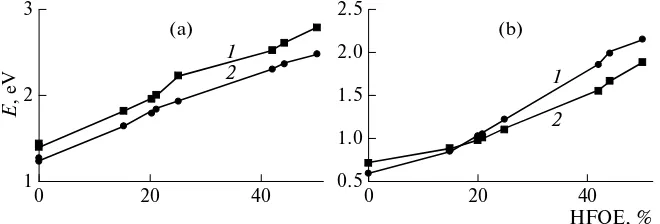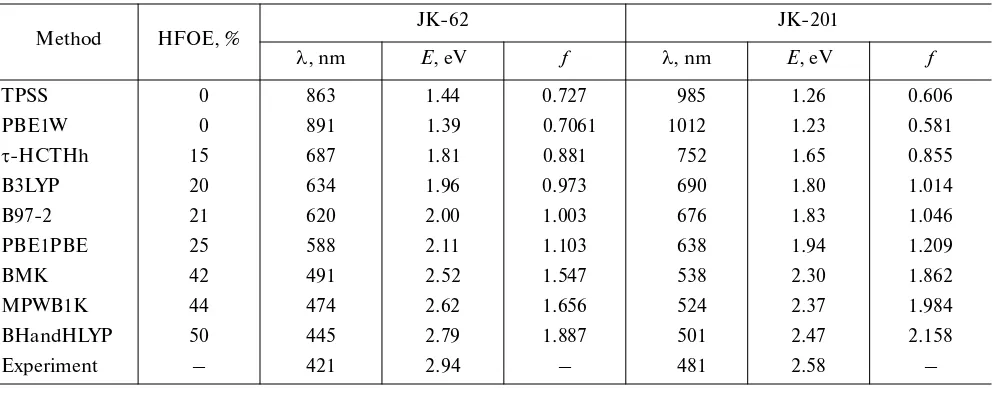INTRODUCTION
Efficient conversion of solar radiation into electric power is an important problem, for solving of which various types of photoelectric converters are being actively developed. Among such devices are dye-sensi-tized solar cells, which have been designed by Grätzel in 1991 [1] and the principle of operation of which is based on photoelectrochemical transformation of light energy into electric current. A determining role in increasing the efficiency of dye-sensitized solar cells is played by the choice of a dye sensitizer with an intensive absorption in a wide spectral interval, which would cover maximally the visible and near-IR ranges [2]. These requirements are met by many organic dyes, in particular, JK-62 [3] and JK-201 [4] bis-dimeth-ylfluorenyl dyes (Fig. 1), which are constructed according to the scheme donor–bridge–acceptor (D-π-A). Elucidation of the nature of absorption of visible light by a dye is the direct problem of quantum chemistry, which can be solved by the method of time-dependent density functional theory (TD DFT) [5].
The basic problem in quantum-chemical modeling of absorption spectra of sensitizing dyes of the D-π-A type by the TD DFT method is frequently related to a strong discrepancy between calculated and experi-mental data on the energy of the lowest S1 charge-transfer state, which is responsible for electron injec-tion and electric-current generainjec-tion in dye-sensitized solar cells. This problem is a characteristic drawback
of the TD DFT method for charge-transfer states [6– 9], and it is known for many types of dyes; however, it manifests itself most strongly for triphenylamine [10– 12] and bis-dimethylfluorenyl dyes [13, 14]. Thus, cal-culations with the use of the well-known B3LYP func-tional underestimate the energy of the S1 state by 0.4– 1.0 eV compared to the experiment.
In this work, we present a system analysis of the contribution from a nonlocal Hartree–Fock orbital exchange to the exchange–correlation part of the functional for the correct quantitative and qualitative description of the S1 charge-transfer state by the example of two sensitizing dyes, JK-62 and JK-201.
METHOD OF CALCULATION
Equilibrium geometrical parameters of the JK-62 and JK-201 dyes were calculated by the DFT/B3LYP method [15, 16] in the 6-31G(d) basis set of atomic orbitals [17]. For the equilibrium geometrical config-uration of either molecule, we calculated 20 singlet excited states by the TD DFT method with the use of a series of functionals that contained different contri-butions of the Hartree–Fock orbital exchange to the exchange–correlation part. The excited states were calculated in terms of the PCM continual model [18] (ethanol and tetrahydrofuran were used as solvents for the JK-62 and JK-201 dyes, respectively, to detect their absorption spectra). For the equilibrium geome-tries, we also analyzed electron-density distribution
CONDENSED-MATTER SPECTROSCOPY
A Study of the Role Played by the Hartree–Fock Orbital Exchange
in the Formation of the Energy of the First Singlet
Charge-Transfer Excited State by the Example of JK-62
and JK-201 Sensitizing Dye Molecules
G. V. Baryshnikov, B. F. Minaev, A. A. Slepets, and V. A. Minaeva Khmelnitsky Cherkassy National University, Cherkassy, 18031 Ukraine
e-mail: glebchem@rambler.ru, bfmin@rambler.ru, giva@online.ua Received July 4, 2013
Abstract—Based on the time-dependent density functional theory with the use of the functionals B3LYP, B97-2, BHandHLYP, BMK, MPWB1K, PBE1W, PBE1PBE, τ-HCTHh, and TPSS in the 6-31G(d) basis
set of atomic orbitals, we have performed a quantum-chemical investigation of electronic and spectral prop-erties of JK-62 and JK-201 bis-dimethylfluorenyl dye sensitizers for Grätzel photoelectric converters. In terms of the Bader theory, we have done a complete analysis of the electron-density distribution function in the dye molecules under study, which proves the occurrence of intramolecular nonvalent interactions, which, in turn, stabilize a planar mutual arrangement of structural fragments of dye molecules. The role that the Har-tree–Fock orbital exchange plays in the energy formation of the first and most intense electronic transition, which is responsible for the primary current generation in a solar cell, has been elucidated.
function ρ(r) by the Bader method (QTAIM) [19], which yields useful data on intramolecular stabiliza-tion of molecules of sensitizing dyes. The energy of the found nonvalent interactions was calculated by the Espinosa formula [20, 21],
(1) where Eint is the energy of the nonvalent contact (in au) and ν(r) is the potential energy density at the cor-responding critical point of the bond. By definition, the critical point corresponds to an extremum of the function ρ(r) in the interatomic space (gradρ(r) = 0). The type of a critical point is determined by the num-ber (ω) and algebraic sum of signs (σ) of curvature
ele-ments (λi) of the electron density at the critical point. For a chemical bond, the form of a critical point in the format (ω, σ) is given by (3, –1). Bader showed that the occurrence of critical point (3, –1) between atoms is a necessary and sufficient condition for the chemical bond to appear [19].
The profiles of the calculated electronic absorption spectra of the JK-62 and JK-201 dye molecule were approximated by the Gauss distribution function (with
int ( ) 2,/ E = νr
a line halfwidth of 3500 cm–1) using the SWizard 4.6. program [22]. All calculations by the DFT and TD DFT methods were performed in terms of the Gauss-ian 03 software package [23] on a PDC supercomputer at the Royal Institute of Technology (Stockholm, Sweden). Topological analysis of the electron-density distribution function ρ(r) was performed by the QTAIM method using the AIMQB program, which was realized in terms of the AIMAll computer com-plex [24].
RESULTS AND DISCUSSION Analysis of the Structure of the JK-62
and JK-201 Dye Molecules
Figure 2 presents graphs of the structure of the dye molecules that were obtained according to calcula-tions by the QTAIM method. For these molecules, we analyzed the energy density and the sign of the Lapla-cian at the (3, –1) critical point and applied the Espi-nosa correlation dependence to find energies of non-valent contacts (Table 1). A detailed analysis and determination of the energy of nonvalent interactions are very important, because it is precisely these weak intramolecular interactions that determine the con-formational structure of dye molecules and, therefore, affect the dynamics of the electron transfer upon pho-toexcitation. In particular, Fukunishi et al. [25] showed that the mutual rotation of donor and acceptor groups of indoline dyes substantially affects the posi-tion and intensity of the first absorpposi-tion band, which corresponds to the charge transfer, i.e., to the primary electric-current generation event in dye-sensitized solar cells. Therefore, the conformation of dye mole-cules “controls” the charge-transfer efficiency upon photoexcitation and directly determines the efficiency of dye-sensitized solar cells.
O1–S1 and H2–O2 interactions. Two critical points
of the (3, –1) type correspond to the O1–S1 and H2– О2 interactions in the JK-201 molecule. For these interactions. The values of electron-density Laplacian and electron-energy density he(r) are positive, which corresponds to the interaction of closed shells. The ellipticity values for these bonds are 0.10 and 0.17, respectively (Table 1), which indicates that these con-tacts are dynamically stable. The energies of the O1–S1 and H2–О2 bonds calculated by formula (1) are –3.01 and –3.20 kcal/mol, respectively (Table 1).
H1–C1 and N1–H1 interactions. The H1–C1 and N1–H1 interactions in the JK-62 and JK-201 mole-cules, respectively, stabilize the planar mutual arrangement of the cyanoacrylic fragment and adja-cent “bridge part.” The values of (r) and he(r) are positive and small in magnitude, which corresponds the interaction of closed shells. The ellipticity values for the H1–C1 and N1–H1 bonds are 0.51 and 0.83, respectively, which indicates that these interactions
2 ( )
(a)
H3 H2
H4 H5
H1
C1
(b)
H1
N1
S1
O1 H2
Fig. 2. Graph structures of (a) JK-62 and (b) JK-201 molecules: points in cycles show (3, +1) critical points and points on bonds
represent (3, –1) critical points.
are considerably susceptible to the break with the cycle opening. The energies of the H1–C1 and N1–H1 bonds calculated by formula (1) are –2.20 and 1.76 kcal/mol, respectively (Table 1).
H2–H3 and H4–H5 interactions. The interactions
of the H–H type in the JK-62 dye molecule are rather strong for bonds of this type (Table 1); however, high ellipticity values for these bonds (0.88 and 1.02 for the H2–H3 and H4–H5 bonds, respectively) indicate that these interactions are susceptible to the break with the cycle opening.
Electronic and Spectral Properties of the JK-62 and JK-201 Dyes
According to the experimental data, the electronic absorption spectra of the JK-62 and JK-201 dyes con-sist of two absorption bands each. Their long-wave-length bands lie in the range of 390–600 nm and are peaked at 421 and 481 nm for JK-62 and JK-201, respectively (Fig. 3). The short-wavelength bands are in the range of 300–390 nm with maxima at 374 and
371 nm for JK-62 and JK-201, respectively [3, 4] (they are not shown). Calculations by the TD DFT/BHandHLYP/6-31G(d) method [26] repro-duce best this shape of the absorption spectra of the JK-62 and JK-201 dyes.
The calculation shows that the first absorption maximum at 421 (481) nm is caused by the singlet– singlet (S0 → S1) electronic transition of the ππ* type and corresponds to one-electron excitation from the highest occupied molecular orbital (HOMO) to the lowest unoccupied molecular orbital (LUMO) (Fig. 4.) From Fig. 4, it can be seen that this transition is accompanied by charge transfer from the donating fluorenylamine part of the dye molecule to the accept-ing cyanoacrylic fragment; i.e., charge separation takes place in the molecule, as a result of which a pho-toexcited electron is localized on the accepting part, whereas, on the donating triphenylamine fragment, a hole is formed. Importantly, this transition is the most intense in the spectrum and produces population of the first S1 state, which relaxes by injecting an electron
nanoc-1.0
440 0.5
0
390 490
1
2
3
A
bso
rp
ti
o
n
(a)
1.0
500 0.5
0
400 600
1
2
3
(b)
λ, nm
Fig. 3. (1) Experimental absorption spectra of the (a) JK-62 and (b) JK-201 dyes in comparison with their spectra calculated by the TD DFT/BHandHLYP/6-31G(d) method: (2) calculation in the vacuum approximation and (3) calculation taking into account the influence of the solvent.
(а) (b)
(c) (d)
rystalline TiO2. The relaxation efficiency of the S1 state is quantitatively determined by the coefficient of the photon–electric conversion, which has been mea-sured experimentally [3, 4] to be about 90% at the absorption maxima of the two dyes adsorbed on the semiconductor surface (the absorption maxima of the dyes adsorbed on TiO2 are insignificantly bathochro-mically shifted with respect to their positions in the absorption spectra of the dyes in the solution). Higher excited states of the dyes manifest themselves in the near-UV range, the fraction of which constitutes about 3% in the solar emission spectrum. Therefore, under conditions of the dye-sensitized solar cell, higher excited states are almost not formed. However, even in the case of their formation, they rapidly relax to the S1 state, which is also useful for pumping of the conduction band of the semiconductor by electrons.
It can be seen from Fig. 4 that the HOMOs and LUMOs of the two dyes have rather vast “common” nonzero overlap regions (outlined by dotted rectan-gles), either of which is localized on the bridge part of the molecule of the JK-62 and JK-201 dyes. This indi-cates that the exchange interaction between these two orbitals is rather strong and should yield an
apprecia-ble contribution to the energy and intensity of the electronic transition between them by means of one-center exchange integrals. Indeed, increasing the part of the nonlocal Hartree–Fock orbital exchange by applying different exchange–correlation functionals leads to a linear increase in the energy of the S1 state
(Fig. 5a; the coefficient of regression, R2 = 0.99; Table 2) and to a better agreement with experimental spectra. The oscillator strength of the first electronic transition also depends on linearly on the part of the Hartree–Fock orbital exchange in the exchange–cor-relation functional (Fig. 5b; the coefficient of regres-sion, R2 = 0.97; Table 2) and increases proportionally with an increase in the contribution of the Hartree– Fock orbital exchange. These effects are determined by nonzero expansion coefficients of the wave func-tions of the HOMO and LUMO on common atoms of the bridge part of the dyes, with these coefficients increasing as the contribution of the Hartree–Fock orbital exchange increases. Their product appears in the expression for the exchange integral and transition electric-dipole moment and, correspondingly, yields large contributions to the transition energy and oscil-lator strength. It is important that, as the part of the Hartree–Fock orbital exchange increases to 100%,
Table 1. Parameters of nonvalent interactions in molecules of the JK-62 and JK-201 dyes
Bond d,Å ρ(r), e ν(r), au he(r), au , e ε E, kcal/mol
JK-62
H4–H5 2.152 0.0092 –0.0049 0.0024 0.0385 1.02 –1.54
H2–H3 2.127 0.0096 –0.0052 0.0024 0.0401 0.88 –1.63
H1–C1 2.438 0.0121 –0.0070 0.0019 0.0436 0.51 –2.20
JK-201
N1–H1 2.586 0.0103 –0.0056 0.0019 0.0376 0.83 –1.76
O1–S1 2.932 0.0127 –0.0096 0.0007 0.0443 0.10 –3.01
H2–O2 2.313 0.0135 –0.0102 0.0012 0.0502 0.17 –3.20
the charge-transfer state acquires the character of a local excitation, which has been demonstrated [27] by the example of a similar triphenylamine dye. There-fore, to correctly describe the S1 charge-transfer state, it is recommended to use functionals with a 40–60% fraction of the Hartree–Fock orbital exchange depending on the degree of coincidence of the energy of the state with the experimental spectrum.
CONCLUSIONS
Our quantum-chemical calculations of the energy and intensity of the first electronic transition S0 → S1
in terms of the TD DFT method by the example of two bis-dimethylfluorenyl dyes, JK-62 and JK-201, have shown that they are highly sensitive to the contribution from the nonlocal Hartree–Fock orbital exchange to the exchange–correlation functional (Table 2). Func-tionals with a small contribution from the Hartree– Fock orbital exchange considerably underestimate the energy of the first S1 charge-transfer state, whereas an increase in the contribution of the Hartree–Fock orbital exchange improves the agreement between the data of calculations and experiment. We have shown that, for this class of sensitizing dyes, the BHandHLYP hybrid functional with a 50% contribution from the Hartree–Fock orbital exchange yields the best agree-ment with experiagree-ment.
Analysis of the conformational structure of mole-cules under study by the Bader method has shown that the planar mutual arrangement of structural fragments of dye molecules is stabilized by intramolecular bonds. Therefore, weak nonvalent interactions directly con-trol the dynamics of the charge transfer over the flat-tened π-conjugated system upon photoexcitation.
REFERENCES
1. B. O’Regan and M. Grätzel, Nature 353 (6346), 737 (1991).
2. A. Hagfeldt, G. Boschloo, L. Sun, L. Kloo, and H. Pet-tersson, Chem. Rev. 110 (11), 6595 (2010).
3. S.-Q. Fan, C. Kim, B. Fang, K.-X. Liao, G.-J. Yang,
7. A. Dreuw and M. Head-Gordon, J. Am. Chem. Soc. 126 (12), 4007 (2004).
8. I. V. Dorogan, Ross. Khim. Zh. 51 (5), 91 (2007). 9. B. Minaev, H. Agren, and F. D. Angelis, Chem. Phys.
358 (3), 245 (2009).
10. B. F. Minaev, G. V. Baryshnikov, and A. A. Slepets, Opt. Spektrosk. 112 (6), 899 (2012).
11. G. V. Baryshnikov, B. F. Minaev, and V. A. Minaeva, Opt. Spektrosk. 110 (2), 243 (2011).
12. B. F. Minaev, G. V. Baryshnikov, and V. A. Minaeva, Dyes Pigm. 92 (1), 531 (2011).
13. S. Kim, J. K. Lee, S. O. Kang, J. Ko, J.-H. Yum, S. Fantacci, F. De. Angelis, D. Di Censo, Md. K. Nazeer-uddin, and M. Grätzel, J. Am. Chem. Soc. 128 (51), 16701 (2006).
14. M. Pastore, E. Mosconi, F. De. Angelis, and M. Graät-zel, J. Phys. Chem. 114 (15), 7205.
15. A. D. Becke, Phys. Rev. A 38 (6), 3098 (1988).
16. C. Lee, W. Yang, and R. G. Parr, Phys. Rev. 37 (2), 785 (1988).
Table 2. Energy and intensity of the transition S0 S1 (calculated taking into account the influence of the solvent) in spectra of the JK-62 and JK-201 dyes in relation to the contribution of the Hartree–Fock orbital exchange (HFOE) to the exchange–correlation functional
Method HFOE, %
JK-62 JK-201
λ, nm Е, eV f λ, nm Е, eV f
TPSS 0 863 1.44 0.727 985 1.26 0.606
PBE1W 0 891 1.39 0.7061 1012 1.23 0.581
τ-HCTHh 15 687 1.81 0.881 752 1.65 0.855
B3LYP 20 634 1.96 0.973 690 1.80 1.014
B97-2 21 620 2.00 1.003 676 1.83 1.046
PBE1PBE 25 588 2.11 1.103 638 1.94 1.209
BMK 42 491 2.52 1.547 538 2.30 1.862
MPWB1K 44 474 2.62 1.656 524 2.37 1.984
BHandHLYP 50 445 2.79 1.887 501 2.47 2.158
17. M. M. Francl, W. J. Petro, W. J. Hehre, J. S. Binkley, M. S. Gordon, D. J. DeFrees, and J. A. Pople, J. Chem. Phys. 77 (7), 3654 (1982).
18. S. Miertus, E. Scrocco, and J. Tomasi, Chem. Phys. 55 (1), 117 (1981).
19. R. F. W. Bader, Atoms in Molecules. A Quantum Theory (Clarendon Press, Oxford, 1990).
20. E. Espinosa, E. Molins, and C. Lecomte, Chem. Phys. Lett. 285 (3–4), 170 (1998).
21. E. Espinosa, I. Alkorta, and I. Rozas, Chem. Phys. Lett. 336 (5–6), 457 (2001).
22. S. I. Gorelsky, http://www.sg-chem.net/ (Univ. Ottawa, Ottawa, 2010).
23. M. J. Frisch, G. W. Trucks, H. B. Schlegel, et al., Gaus-sian 03 (revision C.02) (GausGaus-sian, Inc., Wallingford, 2004).
24. T. A. Keith, www.aim.tkgristmill.com (2010).
25. H. Fukunishi, S. Nakamura, and S. Fujieda, Comp. Theor. Chem. 1014, 29 (2013).
26. A. D. Becke, J. Chem. Phys. 98 (2), 1372 (1993). 27. R. J. Magyar and S. Tretiak, J. Chem. Theory Comput.
3 (3), 976 (2007).




